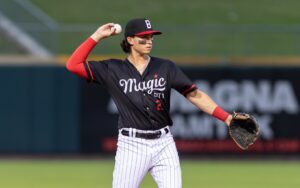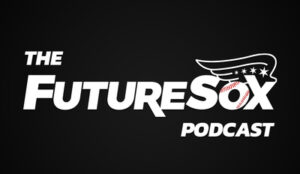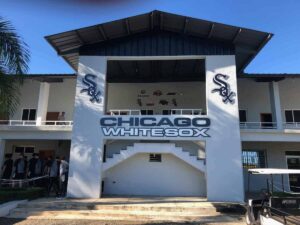2022 White Sox Draft Recap: It’s an arms race for Mike Shirley
In his pre-draft news conference with reporters, amateur scouting director Mike Shirley made it clear that the White Sox should have proven to everyone that they aren’t afraid of drafting prep talent. He also noted that the organization will always gamble on elite upside while recognizing that an influx of pitching was imperative for the franchise.
With the third-smallest bonus pool, the amateur scouting department prepared and executed a slightly different strategy on the first two days of the 2022 amateur draft. In previous seasons, the White Sox employed a plan that required the majority of the bonus pool space to be mostly tied up by just a few players. More seniors and players possessing little leverage were necessary adds on the back end to pay for the premium talent that the organization is always seeking.
The White Sox saved some money towards the end of day two but they used their pool space in a much different variety overall throughout the 2022 class. Shirley noted that the club would be going over slot in rounds two and three and he mentioned that they’d be saving in rounds seven through 10 which indicates that the money will be committed to the college pitchers selected in those spots.
The club possessed $6.2 million in pool space with the ability to get to $6.6 million while utilizing the 5 percent overage cap present in the current rules. The club has been spending pretty close to their maximum allowable every year during recent drafts and while their overall pool is paltry, they should get a solid return for that space.
Breaking Barriers
Despite the fact that his club still hasn’t signed a contract with a player for over $100 million, Rick Hahn thrives on pointing out perceived inequities. The White Sox haven’t selected a high school pitcher in the first round of the draft since taking Providence Catholic’s Kris Honel way back in 2001. Consider that another barrier which has now been broken with the addition of Oswego East southpaw Noah Schultz with the 26th pick in the first round.
Pitching was a known preference for this club this year but the shock still hasn’t quite worn off from the actual selection. Beyond the fact that the White Sox did something that they hadn’t in 20 years, Schultz had a commitment to Vanderbilt in tow while being advised by super agent Scott Boras. There wasn’t a mock draft on the planet with this connection.
“If he doesn’t get mono, Noah Schultz could be going extremely high in this draft,” said Shirley. “You sometimes think about the awkwardness of a guy being 6-foot-9, but he does not move like that. The weapons operate with little effort. You’re talking about a guy who we saw up to 98 miles an hour in his opening start before the mono. He came out hot. Our staff, being that he’s local, was able to get there.”
Rumors persisted in scouting circles that an asking price between $3-$4 million would ultimately result in Schultz pitching for the Commodores next season. Those whispers ultimately turned out to be unfounded as the southpaw has signed with the White Sox and is ready to begin his professional journey.
The White Sox thought that Schultz was available to them due to missing time because of “illness and inclement weather” and the club feels incredibly fortunate.
“This guy has unique skill sets,” said Shirley. “It’s an extreme talent who we think can anchor a rotation someday.” The Oswego East product noted that pitching for the club’s Area Codes Team got him comfortable with area scout JJ Lally and it had a huge impact on him choosing to start his professional career.
Schultz is already large, but he’s projectable still and looks more fluid on the mound than his measurables would initially suggest. He possesses a plus slider that he showed off this summer to go along with a mid-90’s fastball. There’s more velocity to come and mechanical tweaks that will happen along the way. The hurler will need to develop a changeup to combat lefties as a professional and that journey should start in the Arizona Complex League to close out this season.
Arms Race
Taking a prep pitcher in the first round is always a gamble and the club’s recent history with selecting high school arms in general has unsurprisingly been a mixed bag so far. The selection makes plenty of sense in conjunction with the rest of the class, though, and a system lacking pitching depth and impact has been insulated further by the totality of the draft class.
Shirley and his staff selected 12 pitchers total over the course of the 20-round draft and even more have been added after the fact. Peyton Pallette out of Arkansas and Jonathan Cannon from Georgia will be over-slot signings from the second and third rounds, respectively. They immediately become two of the best pitching prospects in the entire farm system.
“It’s an arms race out here,” Shirley said. “We feel like tonight we landed two starters, guys that have the pedigree and the stuff to pitch at the major league level, which we know is very difficult to do today.” The scouting director also noted that Pallette would have been a likely first-rounder as one of the best pitchers in the class prior to undergoing Tommy John surgery in January.
Pallette won’t pitch again in 2022 but he should be one of the better pitching prospects in the system to open 2023. The 6-1, 180-pounder was ranked as the 43rd overall player in the class according to MLB Pipeline. The former Razorback possesses a riding four seam fastball that touches 99 mph with a 78-83 mph hammer curveball as his best pitch.
Cannon was ranked as the No. 60 prospect in the class and the White Sox were able to land him with the 101st selection in the third round with an over-slot bonus. Shirley stated that Cannon “has weapons and resources to work with; it’s the perfect athletic frame and starter pedigree.”
“There were 40-50 innings logged where he hadn’t walked a hitter this year. I think early on in this process, he was dominant. Four-pitch mix, sinker with two breaking balls including a cutter. The pedigree, maneuvered SEC lineups pretty well. The type of guy that could really make a difference”, said Shirley.
Adding two sure-thing college starters to Noah Schultz early in this draft was part of a well executed plan by the entire organization to place a premium on making meaningful pitching additions to the organization. In continuing to pile up arms, Ball State southpaw Tyler Schweitzer and Wake Forest righty Tyler Adler were chosen in rounds five and six.
All jokes aside referencing Shirley landing his annual player from the state of Indiana, Schweitzer’s stock climbed significantly as a junior, propelling him to being named Mid-American Conference Pitcher of the Year. The southpaw pitched on Shirley’s son’s team in the summer of 2020 and the scouting director raved about him getting people out without possessing elite stuff.
Fast-forward to the present, the 6-foot, 180-pounder shows quality spin rates on his four-seamer up in the zone and also possesses three average secondaries with a changeup that has flashed plus. He profiles as a back-end starter in the big leagues. The Ball State Daily News offered a look at how the lefty successfully transitioned to the starting rotation.
Adler has the look of a deadly late inning relief option if the White Sox can get him back on track. The 6-2, 190-pound right-hander shows high 90’s heat with elite spin data on his fastball while also deploying a hard breaking ball that qualifies as plus as well. On the Cape in 2021, Adler was stunning with 29 strikeouts in 15⅔ innings with a 1.15 ERA. He struggled this year with the Demon Deacons but the organization has had success with similar pitchers like Ian Hamilton and Codi Heuer in past drafts.
Tennessee reliever Mark McLaughlin was taken in the seventh round and Shirley offered an explanation on going that direction at the time. Regarding the former Volunteer righty, Shirley said he possessed, “unique metrics with spin components and vertical break that includes a 2900-spin breaking ball”.
More can be read about the prospects selected on day two from the recap by Josh Nelson that was recently posted at Sox Machine. Six more hurlers were added to the organization on day three as well however and it was an interesting mix of data and results based scouting.
Jacksonville University right hander Mason Adams was taken in the 13th round and the senior was ranked No. 496 on the Baseball America Top 500 prior to the draft. He throws lots of strikes with a good feel to pitch but possesses just average stuff overall. He struck out 108 batters and walked 31 in 2022. Shane Murphy is a 6-foot-5-inch left-hander with great command who only threw nine innings for Chandler Gilbert Community College after recovering from Tommy John Surgery.
Murphy is the latest southpaw added to the system by longtime scout John Kazanas. Former Duke right hander Billy Seidl is a relief prospect that misses bats while displaying poor command but simultaneously possessing interesting pitch shape and angle data. Sixteenth-rounder Tristan Stivors was one of the most productive relievers in the nation for Texas State, showing a low-90s fastball and solid breaking ball.
Two-way player Nick Altermatt of Minnesota State-Mankato will at least pitch as a professional and Ethan Hammerberg was added in the 20th round out of Ohio State as well. Jim Margalus wrote about the picks on day three as they were made and information on the players can be read here. Lefties Ben Beutel of Iowa and Jonah Scolaro of Florida State have signed as undrafted free agents along with righties Drew McDaniel of Ole Miss and Kole Ramage of Arkansas.
Going To College For Bats
In a pitching heavy draft class, the White Sox still found a way to add eight position players to their system as well. The most prominent name selected was Jordan Sprinkle out of the University of Santa Barbara in the fourth round. The 21-year-old is one of the best defensive shortstops in the entire class and was getting some first-round love early in the season. He went on to hit just .269/.277/.401 with a 20 percent strikeout rate on the season.
Referencing Sprinkle’s potential, Shirley said he’s an “80 runner; top-of-the-charts speed guy who can play shortstop. That kind of athlete, that kind of mover.” Shirley also surmised that he may have been given some bad advice regarding his offensive game. “I think someone got in Jordan’s ear about trying to be more of a power guy this year and he tried to pull the ball a little bit more and I don’t think that was productive for him. Tried to do too much this spring.”
The White Sox have notoriously liked Team USA guys and Sprinkle was a member of that squad as well. Swing and approach changes could be in order but elite defenders with 80-grade speed are tough to find regardless.
“We were lucky to secure him. He’s an elite athlete that we’re excited about,” Shirley said. The White Sox selected three senior bats to close out day two but there were some intriguing hitters drafted by the club to open day three.
The White Sox don’t typically draft players with 2:1 strikeout-to-walk rates but Jacob Burke‘s “intriguing blend of tools, performance and makeup” had the club deeply engaged into conversations with his agency after day two concluded. The 6-1, 210-pounder is an elite athlete who plays center field and he’s been lauded for his leadership qualities. The outfielder hit .347/.425/.599 with 13 homers for the University of Miami after transferring from Southeast Louisiana last year.
Brooks Baldwin was selected as a third baseman out of UNC Wilmington and he was the Colonial Athletic Association Player of the Year in 2022. The 21-year-old hit .347/.406/.621 with an .OPS over .900 for the second consecutive season. The 6-2 175 pounder is a switch hitter that plays everywhere defensively and was a menace in the Cape Cod League recently. Baldwin possesses plenty of bat speed with line-drive oriented swings that produce extra base hits.
The White Sox used their final three picks on day two to add some college seniors while saving money to pay for their early selections. Second baseman Mario Camilletti of Central Michigan, catcher Michael Turner of Arkansas and Ole Miss slugger Tim Elko were the choices on that day. Camilletti played in 122 games after transferring from Oakland. The left-handed hitting infielder slashed .376/.498/.563 last year with 20 doubles and 11 walks which compares to just 68 strikeouts.
Turner transferred to Arkansas from Kent State and he’s a known as a leader and respected game caller behind the dish. He hits from the left side and batted .323/.388/.502 while clubbing nine homers for the Razorbacks. Elko is a legend at Ole Miss and the recent hero of the College World Series will finally start his professional career.
After tearing his ACL in 2021, the slugger returned to Oxford for a fifth and final season. In 2022, Elko hit .300/.400/.642 with 24 homers and 75 RBI. He’s a high-character leader that will fit into the organization extremely well, but on the diamond he showed unsettling swing-and-miss issues despite the experience and power.
Shirley summarized Elko as “a real bat with power.”
“The heart and soul of that Ole Miss team. SEC is a quality conference. He understands how pitchers attack him and he has tremendous makeup. He’s an icon at Ole Miss. We’re getting a quality character guy,” said Shirley. The scouting director indicated that he’s definitely “power over hit” right now but noted that the injury created a path in which the hitter started to use the opposite field instead of focusing on pulling everything.
The club rounded out their class on day three with a pair of third basemen added to the mix. Bryce Willits was Jordan Sprinkle’s teammate with the Gauchos and the San Diego State third sacker hit .302/.410/.517 this past season but he’s only hit ten homers in 142 college games.
Shelton State Community College’s Drake Logan was taken in the 19th round and the 6-4, 185 pounder was planning to transfer to Alabama to play for the Crimson Tide. He hit .362/.480/.485 this past season. The White Sox will also add outfielder Chris Lanzilli of Arkansas, Texas A&M catcher Troy Claunch and infielders Matt Archer from Lynn and Taishi Nakawake out of UC Irvine as undrafted signings.
While many of these players serve an organizational purpose, the draft is 20 rounds for a reason and area scouts are trying to unearth big leaguers. The 40-man roster of the White Sox is all the evidence needed to realize that big league dreams live on. Adam Engel (19th round), Aaron Bummer (19th round), Danny Mendick (22nd round), Seby Zavala (12th round), Tanner Banks (18th round), Matt Foster (20th round) and Bennett Sousa (10th round) have all contributed to the big league club this year and former 18th-rounder Romy Gonzalez could be added in a pinch.
Mike Shirley and his staff have added 45 players to the system over the course of his three seasons as scouting director. The drafts have each been different but it’s pretty apparent that data will be part of this process going forward, pitching will never be ignored and the club won’t be avoiding high school players any time soon.








I have absolutely no expertise about the draft or prospects so this may be a dumb question. Why is liking Team USA guys considered a bad thing?
It’s not considered a bad thing.
Thanks for the clarification. Since the merger, I’m enjoying the FutureSox content and trying to improve my understanding of the draft and prospects.
However, I’m still unclear. You wrote the Sox have notoriously liked Team USA guys. If liking Team USA guys is not considered a bad thing, where does the notoriety come from?
(I’m asking this out of genuinely wanting to know, not trying to be a jerk.)
It was mostly just a throw away line from me. Team USA guys play with wood bats though and the White Sox have drafted lots of guys over the years who have played on that team. Just another reason why they could have been interested in Sprinkle essentially. It’s probably fair to assume that many teams like Team USA guys though because if they’re on that team, they are probably pretty good. Thanks for reading
I asked my 20-something daughter (who is the writer in the family) and she has informed me that she thinks “notorious” is now used as a synonym for “famous” as well as “infamous”. I had missed this evolution of language so it seems the confusion was all my doing.
Keep up the good work.
Did it change with the There’s no such thing as bad publicity meme?
I’m not sure when this change happened. I’ll use my new understanding when I read but I can’t imagine I personally will ever write or say something like “Jonas Salk is notorious for developing the first polio vaccine.”
I refuse to joint the “people keep using the word wrong so now we’ll just say it means something else” camp. English is a beautiful language when people take the trouble to learn it.
I’m not saying this as a criticism of people who use words incorrectly, because we all do that sometimes, but the reaction to just say that the meaning of the word has evolved irks me.
I see your point and have some sympathy for it but the language does change. I obviously had some confusion about the evolution in the meaning of notorious.
Fare thee well
Love that linguistics pops up in a baseball forum!
English is a beautiful language because it’s malleable and easily evolves.
English teacher checking in to say that English is a beautiful language BECAUSE of its variability and capacity for change.
I get your point and it used to irk me as well. However, I have come around (in the last 6ish years) to feel that language is a tool of the people and if the people evolve the meaning of a word then the language as a whole should accept that.
At the end of the day, language is just noises that convey our thoughts, and if enough people accept the change then that new usage is fulfilling the purpose of language
Phonemes, lexemes, sememes, and White Sox baseball…I love it.
Well said. As I said, I’m sympathetic to @RightSizeWrongShape but I think we have to acknowledge the reality of language evolving. I’m slow to actually adopt new meanings in my speech or writing but I think I have to try to understand new meanings and accept them.
My daughter laughed at me for thinking that the Sox could only be notorious for doing something bad. I don’t think that was kind and I think younger people should be aware that change is hard and they will someday be the ones out of the loop.
I think the worst situation is when an older person knowingly insists on using a meaning from the past. We recently had a lot of discussion here of Engel’s TOOTBLAN. I think it would have been unfortunate if someone had insisted on calling it Engel’s Boner (à la Merkle’s Boner).
The meaning or usage of notorious hasn’t changed. If I said the White Sox are notorious for hiring, and rarely firing, their own you would understand the connotation to be slightly negative re: the White Sox way. Similarly, all things being equal, the Sox will error to the side of Team USA in the draft re: the White Sox way; they’re predictable.
I suggested my son name his band The Merkle Boners. He declined.
The other day I was looking at an excerpt of a chat session my 13 yr niece had with friends, and whoever does not think that the language evolves and changes is not in touch with reality. I thought they were speaking in codes as I couldn’t decipher anything and I suddenly felt so old.
In all seriousness. I love languages, and I love English in particular. I think English is a very neat and efficient language. One of the reasons I love Jim’s blog is not only for his White Sox and baseball content. It is because Jim writes well above average, and to me, it brings me pleasure to read things that are well-written. I love reading so when I read an article that is terribly written, I feel like I have been slapped in the face. I generally stop reading those.
I’m clearly outnumbered here, which is normal in situations like this. I’m an admirer of Bryan Garner, and he refers to words that go through this “evolution” as skunked terms (https://lawprose.org/garners-usage-tip-of-the-day-skunked-terms/). To me, evolution of language would be adding new words to explain new phenomenon. However, I think that when so many people start misusing a word that society finally throws their collective hands up and say, “Oh well, evolution!”, it’s just lazy and ultimately harmful. Just look at the thousands of religious denominations who can’t agree on what the Bible says because they try and impose new meanings to thousands-year-old texts. So anyway, I’ll keep barking at the moon on this one, but I realize it’s a losing fight.
This entire thread is kinda dumb because the root of the word is “publicly known or spoken of”. The negative connotation that everyone here seems to think of as its “original intent” was actually an evolution of the word that most here are complaining about.
Since there appears to be some real interest in linguistics in the community, I’ll suggest that if you are enjoying this thread and haven’t heard the podcast “The Allusionist” you might check it out. Often fascinating, and always strangely hypnotic.
Thanks for the suggestion!
The alternative is to be like Quebec and speak a dialect that never changes and the rest of the French speaking world openly mocks.
Some teams don’t take a lot from Team USA performance because they are not facing the best competition.
Those same teams weigh Cape Cod League performances more than someone does with Team USA.
I should also point out that the White Sox having a heavy presence in North Carolina makes scouting at Cary convenient (Team USA HQ).
“You sometimes think about the awkwardness of a guy being 6-foot-9, but he does not move like that. The weapons operate with little effort.”
I’m sorry but the tape I’ve been looking at says that’s exactly what he moves like. He looks like someone who’s added an extra foot without added any additional weight and is in control of none of it. This isn’t an indictment of the kid who I’ll hold out hope for him coming around but one for Mike Shirley who’s propaganda doesn’t pass the eye test.
You missed an opportunity to say “Shirley you cannot be serious.”
Dammit! That’s why you’re da man Jim.
LOL
Since Shirley took over there’s been a lot of focus on spin rates on pitchers, particularly on breaking balls. Makes me think Kelly might not have been drafted had Shirley been in charge that year
Jared Kelley was taken in the 2nd round of Shirley’s first draft
Ah! Well, nevertheless,
Every time I read about draft selections based on spin rates, I wonder how sticky substances are policed in high school and college. I imagine those levels would be steps behind the big leagues. Anyone know anything about this?
One of my reactions to this draft is that it is a little…strange?…to see them draft a high school pitcher that hardly pitched as a senior in round 1, a college pitcher who didn’t pitch at all this last year in round 2 (and IIRC was not a highly rated prospect in HS), and a college pitcher who had forearm issues followed by some really poor performances at the end of the year. Maybe it’s the new normal, but I guess this begs the question how much they actually saw these guys in action and how much recent track record matters when it comes to how the Sox assess players.
Another reaction is that it will be interesting to follow Drew Gilbert and Tucker Toman, both of whom were mocked to the Sox at different points and were still available when the Sox picked at #26.
It’s certainly a difference in philosophy compared to say, the Cubs draft where they took a guy 7th overall because he had a nice feel for a slider starting a month and a half before the draft.
Personally, I appreciate the long view a bit more. You’re projecting a guy out for what you can turn him into in 3-5 years. Putting too much stock into recent performance can inflate/deflate a guys value arbitrarily.
I guess it’s just hard to say whether there was a long view. Was Schultz scouted by the Sox earlier in high school? And if not, what basis do they have, for example, in thinking he can sustain his velocity into the middle innings? We’re they scouting Pallette in high school, when apparently no one thought much of him? In 2020 when he pitched 5+ innings total? Did they scout him in 2021 when he pitched 56+ innings?
In the end it may not matter much, but I keep thinking about the things scouts were saying pre-draft about Kumar Rocker, ie that it is hard to conclude much of anything about his velocity or his ability to be a starter if you are just seeing him showcase his best stuff for an inning or two at a time. Schultz’s performance in the perfect game league was sort of similar – 6 outings, 19+ innings, and drafted as a starter in round 1.
Schultz is huge and a lefty, and thus has probably been on the local pro and college scouting radar for a few years now, maybe before he ever cracked 90mph; he played for the Sox Area Codes team too if I’m not mistaken. Especially locally, teams will have certain travel ball coaches— pretty much all former professionals now coaching— employed as scouts, who will be plugged into the local baseball network better than anyone. Growing up on the South Side, I played for two guys who did that double duty, one for the Royals and one for the Cubs.
Awesome recap, James!
Peyton Pallette is still my favorite pick of this draft class.